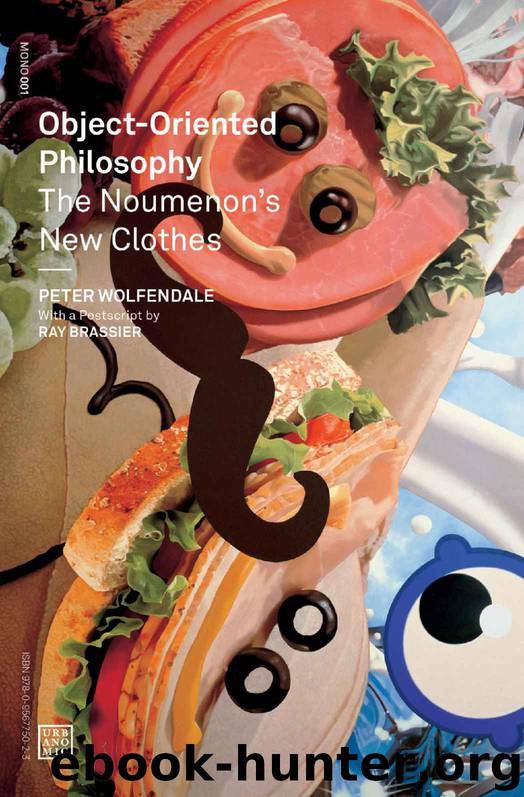Object Oriented Philosophy: The Noumenon's New Clothes by Peter Wolfendale

Author:Peter Wolfendale [Wolfendale, Peter]
Language: eng
Format: azw
ISBN: 9780993045806
Publisher: Urbanomic
Published: 2014-11-03T16:00:00+00:00
II. Existence, Quantification, and Multiplicity
In order to understand Quine’s account of ontological commitment it is necessary to explain how Frege and Russell’s idea that existence is a second-order predicate is formalised by contemporary logic. We have already explained how predicates are usually understood as mathematical functions (e.g., Fx) or open sentences (e.g., ‘…is red’), in which the variable must be given a determinate value (e.g., Fa) or the sentence must be completed with a singular term (e.g., ‘the apple is red’) in order to express a determinate proposition. We now have to introduce the notion of a quantifier, which is understood either as a mathematical function that takes predicates as arguments and returns truth-values (e.g., (∀x)(Fx) and (∃x)(Fx), read as ‘for all x, x is F’ and ‘for some x, x is F’, respectively), or as the main component of a quantified noun phrase that takes the place of a singular term in completing an open sentence (e.g., ‘not all…’ in ‘not all apples’, completing ‘not all apples are red’; ‘most…’ in ‘most integers’, completing ‘most integers aren’t primes’; or even ‘exactly four…’, in ‘exactly four planets’, completing ‘exactly four planets in the solar system are gaseous’).58 The obvious way to understand quantifiers is as devices for quantification, or for expressing the number of things in a given set that meets a certain criteria (e.g., ‘there are nine planets in the solar system’, ‘there are no unicorns on earth’, ‘every electron has a negative charge’, etc.). However, the best way to understand them is in terms of their role in binding the free variables of syntactically well formed formulas (e.g., the quantifier (∀…) binds the variable x in the formula Fx∧Gx to form the proposition (∀x)(Fx∧Gx)), or in progressively completing open sentences by closing the grammatical openings left for singular terms (e.g., the quantified noun phrase ‘most apples’ completing ‘…are green and sharp’ to form the grammatically complete sentence ‘most apples are green and sharp’).
This allows us to draw three overlapping distinctions between types of predicates. Firstly, we can make our earlier distinction between monadic and relational predicates more precise, as we can see that some predicates contain more than one free variable/grammatical opening (e.g., Fxy, or ‘…loves…’) which can be bound/closed by different quantifiers (e.g., (∀x)(∃y)(Fxy), or ‘everybody loves somebody’) even if they needn’t be (e.g., (∀x)(Fxx), or ‘everybody loves themselves’).59 Secondly, we can introduce the distinction between simple and complex predicates, or between predicates whose corresponding formulas/open sentences contain nothing but free variables/openings (e.g., Fx and Gxy, or ‘…is red’ and ‘…loves…’) and predicates whose corresponding formulas/sentences are composed out of simple predicates and logical operators (e.g., Fx ∧ Gx and ¬(Fxy ∧ Fyx), or ‘…is green and sharp’ and ‘…and… don’t love each other’). Finally, we can introduce the distinction between first-order and higher-order predicates, or between those predicates whose variables can only take objects as their values (e.g., Fx where x takes objects {a, b, c, …}) and those predicates whose variables can also take lower-order predicates as values (e.
Download
This site does not store any files on its server. We only index and link to content provided by other sites. Please contact the content providers to delete copyright contents if any and email us, we'll remove relevant links or contents immediately.
The remains of the day by Kazuo Ishiguro(8892)
Tools of Titans by Timothy Ferriss(8304)
Giovanni's Room by James Baldwin(7253)
The Black Swan by Nassim Nicholas Taleb(7056)
Inner Engineering: A Yogi's Guide to Joy by Sadhguru(6752)
The Way of Zen by Alan W. Watts(6553)
Asking the Right Questions: A Guide to Critical Thinking by M. Neil Browne & Stuart M. Keeley(5708)
The Power of Now: A Guide to Spiritual Enlightenment by Eckhart Tolle(5680)
The Six Wives Of Henry VIII (WOMEN IN HISTORY) by Fraser Antonia(5456)
Astrophysics for People in a Hurry by Neil DeGrasse Tyson(5151)
Housekeeping by Marilynne Robinson(4392)
12 Rules for Life by Jordan B. Peterson(4276)
Double Down (Diary of a Wimpy Kid Book 11) by Jeff Kinney(4241)
The Ethical Slut by Janet W. Hardy(4214)
Skin in the Game by Nassim Nicholas Taleb(4203)
Ikigai by Héctor García & Francesc Miralles(4173)
The Art of Happiness by The Dalai Lama(4092)
Skin in the Game: Hidden Asymmetries in Daily Life by Nassim Nicholas Taleb(3961)
Walking by Henry David Thoreau(3923)
